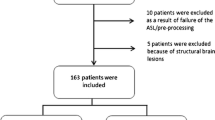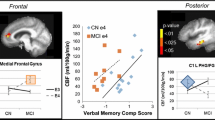Abstract
The association of decreased cerebral blood flow with the development of Alzheimer’s disease (AD) has been a recent target of interest. By using neuroimaging techniques, growing attention has been devoted to the identification of preclinical AD.
In this study, color duplex sonography of cervical arteries was used to measure mean cerebral blood flow (CBF) on 55 amnestic Mild Cognitive Impairment (MCI) patients. Two years after enrolment, excluding patients who progressed to dementia other than AD, two subgroups were identified, patients who developed AD (MCI converters) and patients with preserved cognitive and functional level (MCI non–converters). Examining the mean difference of CBF measured at baseline in the two subgroups obtained, a significant difference was noticed (MCI converters 539.3 ± 114.3 vs MCI non converters 636.0 ± 143.9, p < 0.05). MCI patients with CBF higher than median value (558 ml/min) had lower risk of developing AD (specificity 72.2%, sensitivity 68.4%) within a two year follow–up. Ultrasonography of the cervical arteries is a simple, non invasive and widespread technique useful in detecting CBF decline during the MCI stage, thus identifying patients who later will convert to AD.
Similar content being viewed by others
References
Arnaiz E, Jelic V, Almkvist O, Wahlund L, Winblad B, Valind S, Nordberg A (2001) Impaired cerebral glucose metabolism and cognitive functioning predict deterioration in mild cognitive impairment. Neuroreport 12:851–855
Borroni B, Colciaghi F, Caltagirone C, Rozzini L, Broglio L, Cattabeni F, Di Luca M, Padovani A (2003) Platelet amyloid precursor protein abnormalities in mild cognitive impairment predict conversion to dementia of Alzheimer type: a 2–year follow–up study. Arch Neurol 60(12):1740–1744
Cabrenes JA, De Juan R, Encinas M, Marcos A, Gil P, Fernandez C, De Ugarte C, Barabash A (2004) Relevance of functional neuroimaging in the progression of mild cognitive impairment. Neurol Res 26(5):496–501
Davis HS, Rockwood K (2004) Conceptualization of mild cognitive impairment: a review. Int J Geriatr Psychiatry 19:313–319
de la Torre JC (1999) Critical threshold cerebral perfusion causes Alzheimer’s disease? Acta Neuropathol (Berl) 98(1):1–8
de La Torre JC (2000) Critically attained threshold of cerebral hypoperfusion: can it cause Alzheimer’s disease? Ann N Y Acad Sci 903:424–436
de la Torre JC (2002) Alzheimer disease as a vascular disorder: nosological evidence. Stroke 33(4):1152–1162
de Leon M, Convit A, Wolf OT, Tarnish CY, De Santi S, Rusinek H, Tsui W (2001) Prediction of cognitive decline in normal elderly subjects with 2– [(18)F] fluoro–2–deoxy–D–glucose/ positron–emission tomography (FDG/PET). Proc Natl Acad Sci USA 98:10966–10971
De Santi S, de Leon MJ, Rusinek H, Convit A, Tarshish C, Roche A (2001) Hippocampal formation glucose metabolism and volume losses in MCI and AD. Neurobiol Aging 22:529–539
Fellgiebel A, Siessmeier T, Scheurich A, Winterer G, Bartenstein P, Schmidt LG, Muller MJ (2004) Association of elevated phosphor–tau levels with Alzheimer– typical 18F–fluoro–2–deoxy–Dglucose positron emission tomography findings in patients with mild cognitive impairment. Biol Psychiatry 56(4): 279–283
Huang C, Wahlund LO, Almkvist O, Elehu D, Svensson L, Jonsson T, Winblad B, Julin P (2003) Voxel and VOIbased analysis of SPECT CBF in relation to clinical and psychological heterogeneity of mild cognitive impairment. Neuroimage 19(3): 1137–1144
Imran MB, Kawashima R, Awata S, Sato K, Kinomura S, Ono S, Stato M, Fukuda H (1999) Tc–99m HMPAO SPECT in the evaluation of Alzheimer’s disease: correlation between neuropsychiatric evaluation and CBF images. J Neurol Neurosurg Psychiatry 66(2):228–232
Ishii K, Sasaki M, Yamaji S, Sakamoto S, Kitagaki H, Mori E (1997) Demonstration of decreased posterior cingulate perfusion in mild Alzheimer’s disease by means of H215O positron emission tomography. Eur J Nucl Med 24(6):670–673
Johnson KA, Albert MS (2000) Perfusion abnormalities in prodromal Alzheimer’s disease. Neurobiol Aging 21:289–292
Johnson KA, Jones K, Holman BL, Becker J, Spiers PA, Satlin A, Albert MS (1998) Preclinical prediction of Alzheimer’s disease using SPECT. Neurology 50:1563–1571
Komatani A, Yamaguchi K, Sugai Y, Takanashi T, Kera M, Shinohara M, Kawakatsu S (1998) Assessment of demented patients by dynamic SPECT of inhaled xenon–133. J Nucl Med 29(10): 1621–1626
Maalikjy Akkawi N, Borroni B, Agosti C, Pezzini A, Magoni M, Rozzini L, Prometti P, Romanelli G, Vignolo LA, Padovani A (2003) Volume reduction in cerebral blood flow in patients with Alzheimer’s disease: a sonographic study. Dement Geriatr Cog Disord 16(3):163–169
McKhann G, Drachman D, Folstein, M, Katzman R, Prince D, Stadlan EM (1984) Clinical diagnosis of Alzheimer’s disease: report of the NINCDS–ADRDA:Workgroup under the auspices of the Department of Health and Human Services on Alzheimer’s Disease. Neurology 34:939–994
Meltzer CC, Zubelta JK, Brandt J, Tune LE, Mayberg HS, Frost JJ (1996) Regional hypometabolism in Alzheimer’s disease as measured by positron emission tomography after correction effects of partial volume averaging. Neurology 47:454–461
Morris JC, Storandt M, Miller JP, McKeel DW, Price JL, Rubin H, Berg L (2001) Mild cognitive impairment represents early stage Alzheimer’s disease. Arch Neurol 58:397–405
O’Brien JT, Eagger S, Syed GM, Sahakian BJ, Levy R (1992) A study of regional cerebral blood flow and cognitive performance in Alzheimer’s disease. J Neurol Neurosurg Psychiatry 55:1182–1187
Petersen RC, Smith GE, Waring SC, Ivnik RJ, Tangalos EG, Kokmen E (1999) Mild cognitive impairment: clinical characterization and outcome. Arch Neurol 56:303–308
Ries F, Horn R, Hillekamp J, Honisch C, König M, Solymosi L (1993) Differentiation of multi–infarct and Alzheimer dementia by intracranial hemodynamic parameters. Stroke 24:228–235
Scheel P, Ruge C, Petruch UR, Schöning M (2000) Color duplex measurement of cerebral blood flow volume in healthy adults. Stroke 31:147–150
Scheel P, Puls I, Becker G, Schöning M (1999) Volume reduction in cerebral blood flow in patients with vascular dementia. Lancet 354:2137
Schöning M, Hartig B (1996) Age dependence of total cerebral blood flow volume from childhood to adulthood. J Cereb Blood Flow Metab 16:827–833
Schöning M, Scheel P (1996) Color duplex measurement of cerebral blood flow volume: intra– and interobserver reproducibility and habituation to serial measurements in normal subjects. J Cereb Blood Flow Metab 16:523–531
Schöning M, Walter J, Scheel P (1994) Estimation of cerebral blood flow through color duplex sonography of the carotid and vertebral arteries in healthy adults. Stroke 25:17–22
Shah S, Tangalos EG, Petersen R (2000) Mild cognitive impairment: when is it a precursor of Alzheimer’s disease? Geriatrics 55:65–68
Thomas T, McLendon C, Sutton ET, Thomas G (1997) Beta–Amyloid–induced cerebrovascular endothelial dysfunction. Ann N Y Acad Sci 26(826):447–451
Thomas T, Thomas G, McLendon C, Sutton T, Mullan M (1996) Beta amyloid mediated vasoactivity and vascular endothelial damage. Nature 380:168–171
Author information
Authors and Affiliations
Corresponding author
Rights and permissions
About this article
Cite this article
Maalikjy Akkawi, N., Borroni, B., Agosti, C. et al. Volume cerebral blood flow reduction in pre-clinical stage of Alzheimer disease:. J Neurol 252, 559–563 (2005). https://doi.org/10.1007/s00415-005-0689-z
Received:
Revised:
Accepted:
Published:
Issue Date:
DOI: https://doi.org/10.1007/s00415-005-0689-z




